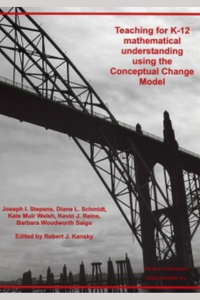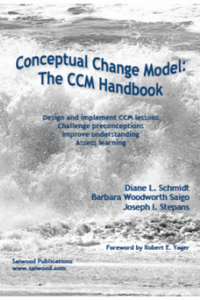Your cart is currently empty!
Teaching for K-12 Mathematical Understanding Using the Conceptual Change Model
$36.00
A book for K-12 teachers, university faculty members, those who are preparing to be teachers, and home-schoolers.
Includes 112 lessons using a proven instructional approach that is aligned with the NCTM standards, learning research, and recommendations for best practices, and that explicitly takes into account the prior experiences learners bring into the classroom.
50 in stock
Description
Authors:
Drs. Joseph I. Stepans (University of Wyoming)
Diane L. Schmidt (Florida Gulf Coast University)
Kate Muir Welsh (University of Wyoming)
Kevin J. Reins (University of South Dakota)
Barbara Woodworth Saigo (Saiwood Resources)
Edited by Dr. Robert J. Kansky (University of Wyoming)
Table of Contents
TITLE PAGE COPYRIGHT PAGE ACKNOWLEDGEMENTS CHAPTER AUTHORSHIP TABLE OF CONTENTS FOREWORD PREFACE Because of the children A unique combination of features The Conceptual Change Model Emphasis and special features of this book A coordinated and coherent approach Aligned components Consistent organization of Chapters 3-7 Who can use this book? References CHAPTER 1: WHY AND HOW SHOULD WE STUDY MATHEMATICS? Why should all students study mathematics? What are the issues? Is the textbook the only or best way to do mathematics? National corroboration for our approach References CHAPTER 2: TEACHING FOR CONCEPTUAL CHANGE IN MATHEMATICS How much do our students really learn? What are some of the problems associated with the way mathematics usually is taught? The learning of mathematics: Some basic principles Why should we investigate students’ entry level? Identifying pre-existing understanding and skills Using the conceptual change approach in this book Overview Figure 2.1: The approach The Conceptual Change Model and why it is powerful Philosophical basis and comparison to Learning Cycle Figure 2.2: The Conceptual Change Model More active learning Less direct instruction, more listening for student understanding Opportunities for teacher inquiry Assessment of learning and evaluation of instruction Assessment of learning Evaluation of instruction An example of aligned instruction and assessment References and other resources CHAPTER 3: NUMBERS AND OPERATIONS A. Focus of the chapter B. Finding out what students bring to the classroom C. Students’ difficulties, confusion, and misconceptions Student difficulties related to place value and basic computational skills Student difficulties related to advanced computational skills D. Factors contributing to students’ difficulties, confusion, and misconceptions E. Background information for the teacher Place value and basic computational skills Advanced computational skills F. Goals, expectations, and assessment NCTM goals and expectations Lesson-specific expectations G. Prerequisite skills and knowledge H. Appropriate instructional strategies I. Evaluation of instruction J. Lessons using the Conceptual Change Model Lesson levels Targeted concepts and instructional materials Lessons Making 10 Adding nines Adding nines: Comments to teachers Subtracting with zeros Estimating marbles Multiplication table Multiplication fact patterns The factor game Multiplying 2-digit numbers by 2-digit numbers Estimating corn kernels Comparing parts Number puzzles Using a balance to learn about properties of numbers Finding the temperature Scale it down Matchbox® car Prime factoring Powerful numbers Ratio and proportion in levers Solar panels & square roots Levers and signed numbers Contexts for signed numbers Estimating the number of names in a phone book Profit or loss? Estimate the thickness & mass of a sheet of paper Estimate the mass & volume of 1 drop of water Sizing up the national debt K. References and other resources CHAPTER 4: MEASUREMENT A. Focus of the chapter B. Finding out what students bring to the classroom Considering developmental level Primary Grades Intermediate Grades Middle School High School C. Students’ difficulties, confusion, and misconceptions D. Factors contributing to students’ difficulties, confusion, and misconceptions E. Background information for the teacher Why should we pay closer attention to measurement? The concept of measurable attributes Units and estimation Two- and three-dimensional measurements Importance of discovery and invention F. Goals, expectations, and assessment NCTM goals and expectations Lesson-specific expectations G. Prerequisite skills and knowledge H. Appropriate instructional strategies Mental modeling Inventive algorithms (formulas) I. Evaluation of instruction J. Lessons using the Conceptual Change Model Lesson levels Targeted concepts and instructional materials Lessons How tall is it? How tall is it? Comments to the teacher Fingers of licorice Cover the desk Which has more? Ordering objects Balancing scales Relationships Puppy pen Comparing volume Cover the box Creating your own standard Measuring boxes Measurement estimations How high is the flagpole? Measuring circular cylinders Measuring things that appear to be immeasurable Determining densities of various kinds of wood Conversions Inventing standards Accuracy and precision Measuring spheres Difficult measurements Heating ice, chilling water (Heat and temperature) Dry or wet—does it matter? (Mass and weight) K. References and other resources CHAPTER 5: ALGEBRA A. Focus of the chapter B. Finding out what students bring to the classroom C. Students’ difficulties, confusion, and misconceptions D. Factors contributing to students’ difficulties, confusion, and misconceptions E. Background information for the teacher About algebra The language of algebra Translating a problem situation into the language of mathematics F. Goals, expectations, and assessment NCTM goals and expectations Lesson-specific expectations G. Prerequisite skills and knowledge H. Appropriate instructional strategies I. Evaluation of instruction J. Lessons using the Conceptual Change Model Lesson levels Targeted concepts and instructional materials Lessons Sorting Repeating patterns Growing patterns Are they equal? Are they equal? Comments to the teacher Growing shapes What comes next? Function boxes Balancing What’s the relationship? Predict the answer Prices of candy and gum Stacking blocks What is the pattern for the polygons? Book lockers Volume versus area Sink or float? Do I have a fever? Geometric and algebraic representations of factoring Dropping a ball Pressure and volume Cookie sale K. References and other resources CHAPTER 6: DATA ANALYSIS AND PROBABILITY A. Focus of the chapter B. Finding out what students bring to the classroom C. Students’ difficulties, confusion, and misconceptions D. Factors contributing to students’ difficulties, confusion, and misconceptions E. Background information for the teacher Why study data analysis and probability in K-12 classrooms? Collection, organization, and use of data, including sampling Statistics, data analysis Probability Representation F. Goals, expectations, and assessment NCTM goals and expectations Dispositions Lesson-specific expectations G. Prerequisite skills and knowledge H. Appropriate instructional strategies I. Evaluation of instruction J. Lessons using the Conceptual Change Model Lesson levels Targeted concepts and instructional materials Lessons Likely or unlikely? Birthday graph Class survey Counting doors in a house What will it be? Sweet research M&M;® bar-to-circle graph Radio station Top 40 survey What colors? What colors? Comments to teachers Formulating questions and methods Population pyramids How far from the school do students live? Inferences and predictions: TV nation Multiplication cubes The burglar Do they add up to a prime number? The loaded die & bias Judging claims To tell the truth Detecting dangerous diseases K. References and other resources CHAPTER 7: GEOMETRY A. Focus of the chapter B. Finding out what students bring to the classroom C. Students’ difficulties, confusion, and misconceptions D. Factors contributing to students’ difficulties, confusion, and misconceptions E. Background information for the teacher Euclidean and non-Euclidean geometry, axiomatic system Deductive thinking and conjecturing Developing geometric language, role of definitions Congruence and similarity van Hieles’ model for geometric thinking F. Goals, expectations, and assessment NCTM goals and expectations Lesson-specific expectations G. Prerequisite skills and knowledge H. Appropriate instructional strategies I. Evaluation of instruction J. Lessons using the Conceptual Change Model Lesson levels Targeted concepts and instructional materials Lessons How are shapes alike and different? Getting a feel for solid geometry Tangram togetherness Rearrangement Congruence by paper folding Ratio of circumference to diameter Fenced in Manhole covers All tied up Doubling a cube’s edge length Covering and filling 3D shapes A borderline problem Similar pentagons Expanding rails Quadrilateral mosaics Making a conjecture for Pythagoras Getting crosswise with trapezoids Composition of transformations Looking in the mirror The right triangle Geometry of soap bubbles K. References and other resources APPENDIX I. INTERVIEWING STUDENTS APPENDIX II. TEACHER INQUIRY, CLASSROOM RESEARCH APPENDIX III-A. CONTRASTING CASES APPENDIX III-B. CONCEPT WEBBING & CONCEPT MAPPING APPENDIX IV. PLANNING FORMAT AND SEQUENCE FOR DESIGNING CCM LESSONS Before lesson design and instruction Instructional plan, using the Conceptual Change Model A. The lesson B. Assessment (of student learning) C. Evaluation (of instruction) D. Outline/overview of lesson plan format for the CCM APPENDIX V. ABOUT THE AUTHORS, EDITOR, AND REVIEWERS The authors The editor The reviewers YOUR FEEDBACK A PROFESSIONAL INVITATION
Reviews from Teachers
“Accessible for any teacher. The lessons are practical, clear, and well-written, and will be useful to both the veteran and rookie teacher in making progress with any group of students. This is the first book I’ve read that finally puts together the NCTM standards with a teaching strategy and lessons that make sense. If you are using or thinking about using a “reform” math program, read this book!” (KDM, K-6 mathematics teacher)
“Before this book I had to search for the NCTM standards in one source, roud up related activities on my own, read background information in multiple books, and create my own matrices. This book contains all of these in one volume.” (JE, 3rd grade teacher)
“The CCM teaching strategy focuses on the learner’s thoughts … It puts the responsibility of the learning on the learner, through a sense of curiosity and adventure. Lessons are geared to various levels but it is always stated that they are flexible enough to be delivered to any students who are cognitively ready, regardless of age.” (SQ, high school mathematics teacher)
“Another great strength is that the deceptively easy concepts in these lessons are taught in great depth if the lesson format is followed. The focus on continually refining instruction to facilitate conceptual development is to be applauded.” (BY, 4th grade teacher)
“The CCM lessons have given me a constructivist and engaging way to teach mathematics. The approach of the book is positive, encouraging mathematical engagement. The way the lessons are written gives the student a chance to explore, discover, question, and collaborate while learning mathematics.” (JV, 5th grade teacher)
“This book does a very inclusive job of integrating the research about learning and learner misconceptions with the NCTM Standards.” (BY, 4th grade teacher)
“The CCM and lessons we tried were very teacher friendly. It works well with what we are doing in our district.” (TE, 4th grade teacher)
“I love the lessons. My children enjoy them so much, and they go along with the Bridges math program.” (SR, 2nd grade teacher)
“Our new Everyday Math program maintains a constructivist approach. The CCM is a perfect fit with our program. The background information for the teacher reduces some of the fear factor. I’m seeing comfort level changes in my class as they discuss their strategies, find their own mistakes, learn from the approaches of other kids. I’m improving as a facilitator, giving more time and trust to the children to discover on their own.” (JE, 3rd grade teacher)
“The book provides me with well-described and supported theory and the guidance to put it into practice. It presents developmentally appropriate CCM lessons that I can easily use in my classroom.” (LCW, 4th grade teacher)
“Each chapter is clearly outlined and bold headings make finding information more successful.” (JM, 4th grade teacher)



